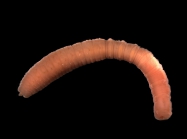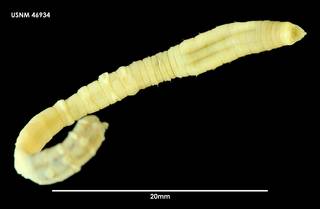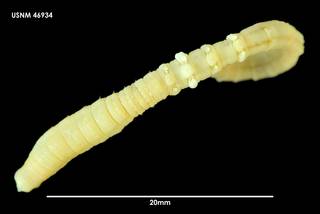WoRMS taxon details
Notomastus latericeus Sars, 1851
129898 (urn:lsid:marinespecies.org:taxname:129898)
page(s): 199-200 [details]
separated into a...
separated into a relatively thick, cylindrical anterior end coloured purple to dark red and a thinner
bright red or yellowish posterior end. The head is short and conical. The species lives in a spiralled burrow. [details]
Distribution Notomastus latericeus has a relatively low frequency of occurrence, but is found across the entire Belgian part of the...
Distribution This species is quite common at the Oyster Ground. N. latericeus also occurs at a few locations in the south-western part...
Distribution Saguenay Fjord, lower St. Lawrence estuary; Prince Edward Island (from the northern tip of Miscou Island, N.B. to Cape...
![]() The webpage text is licensed under a Creative Commons
Attribution 4.0 License
The webpage text is licensed under a Creative Commons
Attribution 4.0 License
Nomenclature
page(s): 199-200 [details]
original description (of Arenia cruenta Quatrefages, 1866) Quatrefages, A. (1866). Histoire naturelle des Annelés marins et d'eau douce. Annélides et Géphyriens. <b>Volume 2.</b>. Première partie. 1-336. Deuxième Partie. 337-794. Explication des planches p.1-24. planches 1-20. Librarie Encyclopédique de Roret. Paris., available online at http://books.google.com/books?id=M_xNAAAAcAAJ
page(s): 250-251, plate 11 figs. 16-23 [details]
original description (of Arenia fragilis Quatrefages, 1866) Quatrefages, A. (1866). Histoire naturelle des Annelés marins et d'eau douce. Annélides et Géphyriens. <b>Volume 2.</b>. Première partie. 1-336. Deuxième Partie. 337-794. Explication des planches p.1-24. planches 1-20. Librarie Encyclopédique de Roret. Paris., available online at http://books.google.com/books?id=M_xNAAAAcAAJ
page(s): 251-252, plate 11 figs. 24-27 [details]
original description (of Capitella rubicunda Keferstein, 1862) Keferstein, W. (1862). Untersuchungen über niedere Seethiere. <em>Zeitschrift für wissenschaftliche Zoologie.</em> 12(1): 1–147 plates 1–11., available online at https://www.biodiversitylibrary.org/page/44977773
page(s): 123-126, plate XI figs. 7-18 [details]
original description (of Notomastus benedeni Claparède, 1864) Claparède, Édouard. (1864). Glanures zootomiques parmi les annélides de Port-Vendres (Pyrénées Orientales). <em>Mémoires de la Société de Physique et d'Histoire Naturelle de Genève.</em> 17(2): 463-600, plates I-VIII., available online at https://doi.org/10.5962/bhl.title.1972
page(s): 514-516, plate IV fig. 9 [details]
original description (of Notomastus (Tremomastus) fertilis Eisig, 1887) Eisig, H. 1887. Monographie der Capitelliden des Golfes von Neapel und der angrenzenden meeres-abschnitte nebst untersuchungen zur vergleichenden anatomie und physiologie. Fauna und Flora des Golfes von Neapel und der angrenzenden Meeres-Abschnitte, 16: xxvi + 906 pp. + 37 plates., available online at https://doi.org/10.5962/bhl.title.7348 [details]
basis of record Bellan, G. (2001). Polychaeta, <i>in</i>: Costello, M.J. <i>et al.</i> (Ed.) (2001). European register of marine species: a check-list of the marine species in Europe and a bibliography of guides to their identification. <em>Collection Patrimoines Naturels.</em> 50: 214-231. (look up in IMIS) [details]
Other
context source (HKRMS) BU. (2013). Provision of services for field sampling, species identification and data analysis of benthic faunal communities of Hong Kong marin waters. Final report submitted to EPD. [details]
context source (Schelde) Maris, T., O. Beauchard, S. Van Damme, E. Van den Bergh, S. Wijnhoven & P. Meire. (2013). Referentiematrices en Ecotoopoppervlaktes Annex bij de Evaluatiemethodiek Schelde-estuarium Studie naar “Ecotoopoppervlaktes en intactness index”. [Reference matrices and Ecotope areas Annex to the Evaluation methodology Scheldt estuary Study on “Ecotope areas and intactness index”. <em>Monitor Taskforce Publication Series, 2013-01. NIOZ: Yerseke.</em> 35 pp. (look up in IMIS) [details]
context source (BeRMS 2020) Bio-environmental research group; Institute of Agricultural and Fisheries research (ILVO), Belgium; (2015): Macrobenthos monitoring in function of the Water Framework Directive in the period 2007-2009. [details]
context source (Bermuda) Sterrer, W. (1986). Marine fauna and flora of Bermuda: a systematic guide to the identification of marine organisms. <em>Wiley-Interscience Publication. Wiley.</em> 742 pp (Nemertini part). [details] Available for editors
additional source Brunel, P., L. Bosse & G. Lamarche. (1998). Catalogue of the marine invertebrates of the estuary and Gulf of St. Lawrence. <em>Canadian Special Publication of Fisheries and Aquatic Sciences, 126.</em> 405 pp. (look up in IMIS) [details] Available for editors
additional source Day, J. H. (1967). [Sedentaria] A monograph on the Polychaeta of Southern Africa. Part 2. Sedentaria. British Museum (Natural History), London. pp. 459–842., available online at http://www.biodiversitylibrary.org/bibliography/8596 [details]
additional source Muller, Y. (2004). Faune et flore du littoral du Nord, du Pas-de-Calais et de la Belgique: inventaire. [Coastal fauna and flora of the Nord, Pas-de-Calais and Belgium: inventory]. <em>Commission Régionale de Biologie Région Nord Pas-de-Calais: France.</em> 307 pp., available online at http://www.vliz.be/imisdocs/publications/145561.pdf [details]
additional source Chamberlin, Ralph V. (1919). The Annelida Polychaeta [Albatross Expeditions]. <em>Memoirs of the Museum of Comparative Zoology at Harvard College.</em> 48: 1-514., available online at http://www.biodiversitylibrary.org/ia/memoirsofmuseumo4801harv [details]
additional source Fauvel, P. 1907. Première note préliminaire sur les Polychètes provenant des campagnes de l'Hirondelle et de la Princesse-Alice ou déposées dans le Musée Océanographique de Monaco. Bulletin de l'Institute océanographique, 107: 1-34. [details]
additional source Fauvel, Pierre. (1909). Deuxième note préliminaire sur les polychètes provenant des campagnes de l'<i>Hirondelle</i> et de la <i>Princesse-Alice</i>, ou déposées dans la Musée Océanographique de Monaco. <em>Bulletin de l'Institute Océanographique de Monaco.</em> 142: 1-76., available online at http://biodiversitylibrary.org/page/46491917 [details]
additional source Fauvel, P. (1926). Sur les capitelliens. <em>Bulletin de la Société Zoologique de France.</em> 51: 296-301., available online at http://gallica.bnf.fr/ark:/12148/bpt6k5445912x/f307.item [details]
additional source Hartman, O. (1951). The littoral marine annelids of the Gulf of Mexico. <em>Publications of the Institute of Marine Science, Port Aransas, Texas.</em> 2(1): 7-124., available online at http://hdl.handle.net/2152/22162
page(s): 102 [details] Available for editors
additional source Sars, M. (1856). Nye Annelider. <em>Fauna littoralis Norvegiae (Fredrik D. Beyer. Bergen).</em> heft 2:1-24., available online at http://biodiversitylibrary.org/page/41477013
page(s): 9-13, plate II figs. 8-17 [details]
additional source Thomassin, B.A. (1970). Contribution à l'étude des polychètes de la région de Tuléar (S.W. de Madagascar). III. Sur les Capitellidae des sables coralliens. <em>Recueil des Travaux de la Station Marine d'Endoume.</em> 10: 71-101.
page(s): 83-86, fig. 8 [details] Available for editors
additional source Fauchald, K.; Granados-Barba, A.; Solís-Weiss, V. (2009). Polychaeta (Annelida) of the Gulf of Mexico, Pp. 751–788 in D.L. Felder and D.K. Camp (eds.). <em>Gulf of Mexico. Origin, Waters, and Biota. Volume 1, Biodiversity.</em> Texas A&M University Press, College Station, Texas., available online at https://books.google.es/books?id=CphA8hiwaFIC&lpg=PR1&pg=PA751 [details]
additional source Liu, J.Y. [Ruiyu] (ed.). (2008). Checklist of marine biota of China seas. <em>China Science Press.</em> 1267 pp. (look up in IMIS) [details] Available for editors
additional source Trott, T. J. (2004). Cobscook Bay inventory: a historical checklist of marine invertebrates spanning 162 years. <em>Northeastern Naturalist.</em> 11, 261-324., available online at http://www.gulfofmaine.org/kb/files/9793/TROTT-Cobscook%20List.pdf [details] Available for editors
additional source Fauchald, K. (1977). The polychaete worms, definitions and keys to the orders, families and genera. <em>Natural History Museum of Los Angeles County: Los Angeles, CA (USA), Science Series.</em> 28:1-188., available online at http://www.vliz.be/imisdocs/publications/123110.pdf [details]
additional source Integrated Taxonomic Information System (ITIS). , available online at http://www.itis.gov [details]
 Present
Present  Present in aphia/obis/gbif/idigbio
Present in aphia/obis/gbif/idigbio  Inaccurate
Inaccurate  Introduced: alien
Introduced: alien  Containing type locality
Containing type locality
Biology Pelagic larvae have been found in December, February and April, whereas settling has been observed in August-October. The settling larvae prefer mud and sand above clean shell gravel and are not very tolerant to low salinities.
N. latericeus is tubicolous as a juvenile, but free-living when adult. Adult specimens build partially spiralled burrows that maintain integrity for some time after construction, but lack a distinct wall structure. Capitellids are mentioned to be non-selective deposit feeders, although N. latericeus may prove to be more selective as suggested by its gut contents. The species is recorded living as a commensal with the entoproct Loxosoma singulare (Hartmann-Schröder, 1971; Wolff, 1973; Fauchald & Jumars, 1979). [details]
Description Simple bristle worm without distinct appendages. The body is relatively long (up to 300 mm) and is
separated into a relatively thick, cylindrical anterior end coloured purple to dark red and a thinner
bright red or yellowish posterior end. The head is short and conical. The species lives in a spiralled burrow. [details]
Distribution Notomastus latericeus has a relatively low frequency of occurrence, but is found across the entire Belgian part of the North Sea. The species is almost completely (1976-1986 period) or even completely absent (1994-2001 period) in the eastern coastal zone only. In the 1976-1986 period densities remained below 100 ind./m2 whereas densities up to approximately 600 ind./m2 were recorded in the 1994-2001 period. [details]
Distribution This species is quite common at the Oyster Ground. N. latericeus also occurs at a few locations in the south-western part of the Southern Bight, near the coast and in the marine part of the Delta area. [details]
Distribution Saguenay Fjord, lower St. Lawrence estuary; Prince Edward Island (from the northern tip of Miscou Island, N.B. to Cape Breton Island south of Cheticamp, including the Northumberland Strait and Georges Bay to the Canso Strait causeway); Cobscook Bay [details]
Habitat Known from seamounts and knolls [details]
Habitat Notomastus latericeus has no clear preference for a specific median grain size: the habitat preference appears to be mainly determined by the mud content. Sediments with a mud content of 0 to 50% are suitable for N. latericeus, but the species displays a preference for sediments with a mud content of 10-30% (relative occurrence: > 50%). [details]
Habitat In the study area N. latericeus shows a clear preference for fine muddy sand. In the southernmost part of the Southern Bight the species is found in coarse sand. [details]
Habitat bathyal, infralittoral and circalittoral of the Gulf and estuary [details]
Morphology Like most members of the Capitellidae this is a species with a simple, smooth body, lacking any appendages other than short chaetae. The head is short, triangular and smooth. The species has an eversible sac-like pharynx. The body is relatively long, up to 150 mm, and made up of 150 segments, which are of two types and divided over two body regions. The anterior region is relatively thick, cylindrical and purple or dark red. The tail region is more slender and bright red or yellowish (Hartmann-Schröder, 1971; Hayward & Ryland, 1990). [details]
| Language | Name | |
|---|---|---|
| Japanese | シダレイトゴカイ | [details] |
To Barcode of Life (13 barcodes)
To Biodiversity Heritage Library (13 publications) (from synonym Arenia fragilis Quatrefages, 1866)
To Biodiversity Heritage Library (14 publications) (from synonym Notomastus rubicundus (Keferstein, 1862))
To Biodiversity Heritage Library (3 publications) (from synonym Notomastus benedeni Claparède, 1864)
To Biodiversity Heritage Library (76 publications)
To Biological Information System for Marine Life (BISMaL)
To European Nucleotide Archive, ENA (Notomastus latericeus)
To GenBank (13 nucleotides; 6 proteins)
To Global Biotic Interactions (GloBI)
To NMNH Extant Collection (Notomastus latericeus (1) 46934)
To NMNH Extant Collection (Notomastus latericeus 46934)
To PESI
To PESI (from synonym Notomastus rubicundus (Keferstein, 1862))
To The Arctic Traits Database (28 traits)
To USNM Invertebrate Zoology Annelida Collection (2012 records)
To ITIS











